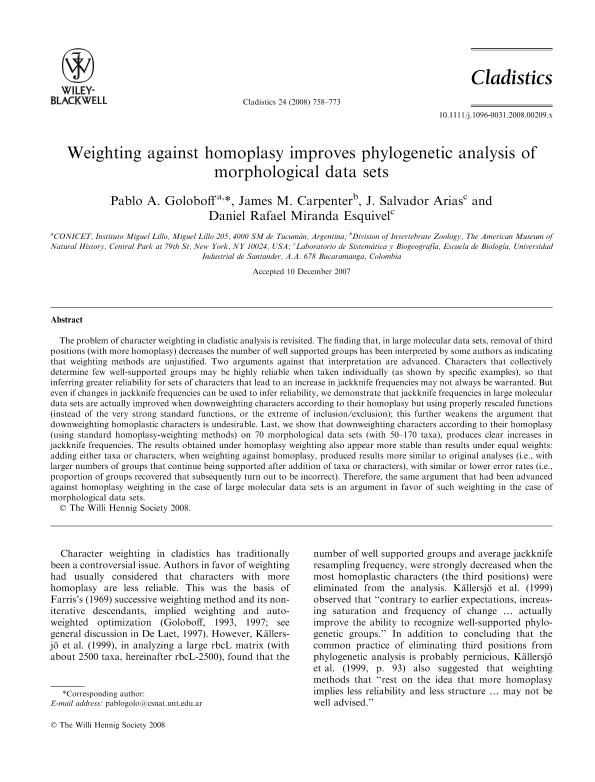Mostrar el registro sencillo del ítem
dc.contributor.author
Goloboff, Pablo Augusto

dc.contributor.author
Carpeneter, James M.
dc.contributor.author
Arias Becerra, Joan Salvador

dc.contributor.author
Miranda Esquivel, Daniel Rafael
dc.date.available
2019-08-22T18:27:10Z
dc.date.issued
2008-10
dc.identifier.citation
Goloboff, Pablo Augusto; Carpeneter, James M.; Arias Becerra, Joan Salvador; Miranda Esquivel, Daniel Rafael; Weighting against homoplasy improves phylogenetic analysis of morphological data sets; Wiley Blackwell Publishing, Inc; Cladistics; 24; 5; 10-2008; 758-773
dc.identifier.issn
0748-3007
dc.identifier.uri
http://hdl.handle.net/11336/82003
dc.description.abstract
The problem of character weighting in cladistic analysis is revisited. The finding that, in large molecular data sets, removal of third positions (with more homoplasy) decreases the number of well supported groups has been interpreted by some authors as indicating that weighting methods are unjustified. Two arguments against that interpretation are advanced. Characters that collectively determine few well-supported groups may be highly reliable when taken individually (as shown by specific examples), so that inferring greater reliability for sets of characters that lead to an increase in jackknife frequencies may not always be warranted. But even if changes in jackknife frequencies can be used to infer reliability, we demonstrate that jackknife frequencies in large molecular data sets are actually improved when downweighting characters according to their homoplasy but using properly rescaled functions (instead of the very strong standard functions, or the extreme of inclusion ⁄ exclusion); this further weakens the argument that downweighting homoplastic characters is undesirable. Last, we show that downweighting characters according to their homoplasy (using standard homoplasy-weighting methods) on 70 morphological data sets (with 50?170 taxa), produces clear increases in jackknife frequencies. The results obtained under homoplasy weighting also appear more stable than results under equal weights: adding either taxa or characters, when weighting against homoplasy, produced results more similar to original analyses (i.e., with larger numbers of groups that continue being supported after addition of taxa or characters), with similar or lower error rates (i.e., proportion of groups recovered that subsequently turn out to be incorrect). Therefore, the same argument that had been advanced against homoplasy weighting in the case of large molecular data sets is an argument in favor of such weighting in the case of morphological data sets.
dc.format
application/pdf
dc.language.iso
eng
dc.publisher
Wiley Blackwell Publishing, Inc

dc.rights
info:eu-repo/semantics/openAccess
dc.rights.uri
https://creativecommons.org/licenses/by-nc-sa/2.5/ar/
dc.subject
Phylogenetics
dc.subject
Character Weighting
dc.subject
Methodology
dc.subject
Parsimony
dc.subject.classification
Biología

dc.subject.classification
Ciencias Biológicas

dc.subject.classification
CIENCIAS NATURALES Y EXACTAS

dc.title
Weighting against homoplasy improves phylogenetic analysis of morphological data sets
dc.type
info:eu-repo/semantics/article
dc.type
info:ar-repo/semantics/artículo
dc.type
info:eu-repo/semantics/publishedVersion
dc.date.updated
2019-08-14T20:08:50Z
dc.journal.volume
24
dc.journal.number
5
dc.journal.pagination
758-773
dc.journal.pais
Estados Unidos

dc.journal.ciudad
New York
dc.description.fil
Fil: Goloboff, Pablo Augusto. Consejo Nacional de Investigaciones Científicas y Técnicas. Centro Científico Tecnológico - Tucumán. Unidad Ejecutora Lillo; Argentina
dc.description.fil
Fil: Carpeneter, James M.. The American Museum of Natural History; Estados Unidos
dc.description.fil
Fil: Arias Becerra, Joan Salvador. Universidad Industrial de Santander; Colombia. Universidad Nacional de Tucumán. Facultad de Ciencias Naturales e Instituto Miguel Lillo; Argentina
dc.description.fil
Fil: Miranda Esquivel, Daniel Rafael. Universidad Industrial de Santander; Colombia
dc.journal.title
Cladistics

dc.relation.alternativeid
info:eu-repo/semantics/altIdentifier/doi/https://dx.doi.org/10.1111/j.1096-0031.2008.00209.x
dc.relation.alternativeid
info:eu-repo/semantics/altIdentifier/url/https://onlinelibrary.wiley.com/doi/full/10.1111/j.1096-0031.2008.00209.x
Archivos asociados
